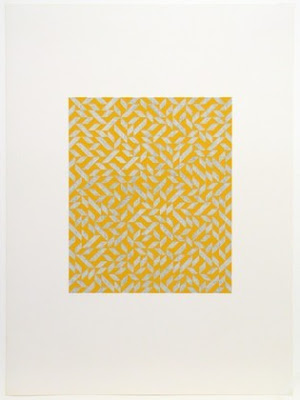Week 4: Connecticut
 Anni Albers, Plate II from the portfoli Line Involvements, (June 8-15, 1964). Lithograph, composition and sheet: 14 3/4 x 19 13/16" (37.5 x 50.3 cm). Gift of Kleiner, Bell & Co. © 2009 The Josef and Anni Albers Foundation / Artists Rights Society (ARS), New York. Courtesy of the Museum of Modern Art.
Anni Albers, Plate II from the portfoli Line Involvements, (June 8-15, 1964). Lithograph, composition and sheet: 14 3/4 x 19 13/16" (37.5 x 50.3 cm). Gift of Kleiner, Bell & Co. © 2009 The Josef and Anni Albers Foundation / Artists Rights Society (ARS), New York. Courtesy of the Museum of Modern Art.After leaving Black Mountain College, Anni and Josef Albers moved to Connecticut, where Josef was chairman of the Department of Design at the Yale University School of Art,from 1950 to 1958.[1] This move, of course, in no way slowed Albers down. While in Connecticut, where Anni and Josef settled for the remainder of their lives, Anni continued to weave, design and write.[2] As Nicholas Fox Weber recalls about the Albers in his book The Bauhaus Group:
The couple in their white khaki clothing spoke with unparalleled clarity and intensity about the making of art. They emphasized the need for morality and modesty in painters, designers, and architects, as in everyone else who hoped to advance humanity. They both marveled at simple things - the form of an egg, the cleverness of egg cartons - just as they deplored pretense and corruption, of which they considered the New York art world a prime exemplar. These were just some of the ways in which they kept the true spirit of the Bauhaus alive.[3]

Anni Albers, W/CO, 1974. Screenprint and photolithograph, offset printed. Gift of the Josef and Anni Albers Foundation in fond memory of Eunice Fearer. © 2009 The Josef and Anni Albers Foundation / Artists Rights Society (ARS), New York. Courtesy of the Museum of Modern Art.
While textiles and weaving continued to be her main focus, in 1963, Anni Albers began to explore the new medium of printmaking, producing a group of lithographs and screenprints of great spatial and textural complexity.[4] What's interesting about Albers' work at this time is the very distinct sense of experimentation. Albers wanted to be able to reproduce her own deliberately irregular pencil work, allow for crystalline edges and to capture a range of grays that had never been possible in any other of the print mediums in which she'd worked, and so she chose to learn the photo-offset process - a combination of photographic repoduction and printing - combining this with traditional screenprinting in order to achieve the desired effect in her work.[5]
It was also during this time, in 1965, that Albers published what would become her most well-known and celebrated text, On Weaving.[6] As the Josef and Anni Albers Foundation explain about this period of her life, "Like Josef, she focused above all on her work—happy to pursue it at a remove from the trends and shifting fashions of the art world. In 1984, Anni wrote, '... to comprehend art is to confide in a constant.'"[7]
[1] The Josef and Anni Albers Foundation online, “An Introduction,” http://www.albersfoundation.org/Albers.php?inc=Introduction (accessed November 24, 2009).
[2] Ibid.
[3] Nicholas Fox Weber, "Anni Albers," The Bauhaus Group (New York: Alfred A. Knopf, 2009), 380.
[4] The Josef and Anni Albers Foundation online, “An Introduction,” http://www.albersfoundation.org/Albers.php?inc=Introduction (accessed November 24, 2009).
[4] The Josef and Anni Albers Foundation online, “An Introduction,” http://www.albersfoundation.org/Albers.php?inc=Introduction (accessed November 24, 2009).


It's spelled Josef.
ReplyDeleteNice catch, and thanks! Looks like I had the correct spelling only about 1/3 of the time, which is not such a good record.
ReplyDelete